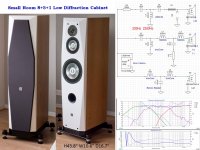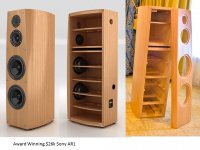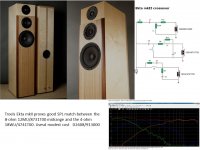I love to read about your speakers and 25 years after my first DIY loudpeakers I have to build new one.
Knowing that you it is hard to answering questions regarding sound taste I still hope that you can help me with decisiont. Just some facts:
1. My living room is cca 17m2 connected with dinning room cca 12m2
2. One year ago I bought Naim Atom (40 Wpc) with a lovely sound. I will keep it.
3. Main goal is to listen at the evenings with low volume and I want to have LIVE FEEL of music with deep bass with all details (rock, jazz, no classic)
4. I have a WIFE, so speakers must fit in - I think about slim floor-standers...
I'm thinking about EKTA-mk2 (or similar), TOWT-mk3, Jenzen SEAS ER/CA...
...which is most enjoyable and non fatique speaker (I suppose Ekta is one of them)
...is my amp enough for Ekta mkII (low eficiency...l
I know it is hard but I will really appreciate your suggestions and help
Thank you for answers!
Knowing that you it is hard to answering questions regarding sound taste I still hope that you can help me with decisiont. Just some facts:
1. My living room is cca 17m2 connected with dinning room cca 12m2
2. One year ago I bought Naim Atom (40 Wpc) with a lovely sound. I will keep it.
3. Main goal is to listen at the evenings with low volume and I want to have LIVE FEEL of music with deep bass with all details (rock, jazz, no classic)
4. I have a WIFE, so speakers must fit in - I think about slim floor-standers...
I'm thinking about EKTA-mk2 (or similar), TOWT-mk3, Jenzen SEAS ER/CA...
...which is most enjoyable and non fatique speaker (I suppose Ekta is one of them)
...is my amp enough for Ekta mkII (low eficiency...l
I know it is hard but I will really appreciate your suggestions and help
Thank you for answers!
May be best to send Troels an email asking about speakers for low volume use. I'd have thought something with his JA8008 would be good.
I like the simplicity of 8008-CORNER, but it is not floor stander.
Maybe SBA-16-MTM. It has higher efficiency than EKTA and is simpler.
Maybe SBA-16-MTM. It has higher efficiency than EKTA and is simpler.
Yes, I already contact Troels but I would like to hear or at least discus about sound.
I know it is hard to do that, but I don't know where to see or test his designs...
I know it is hard to do that, but I don't know where to see or test his designs...
Yes, I already contact Troels but I would like to hear or at least discus about sound.
I know it is hard to do that, but I don't know where to see or test his designs...
YouTube
FYI.
I love to read about your speakers and 25 years after my first DIY loudpeakers I have to build new one.
Knowing that you it is hard to answering questions regarding sound taste I still hope that you can help me with decisiont. Just some facts:
1. My living room is cca 17m2 connected with dinning room cca 12m2
2. One year ago I bought Naim Atom (40 Wpc) with a lovely sound. I will keep it.
3. Main goal is to listen at the evenings with low volume and I want to have LIVE FEEL of music with deep bass with all details (rock, jazz, no classic)
4. I have a WIFE, so speakers must fit in - I think about slim floor-standers...
I'm thinking about EKTA-mk2 (or similar), TOWT-mk3, Jenzen SEAS ER/CA...
...which is most enjoyable and non fatique speaker (I suppose Ekta is one of them)
...is my amp enough for Ekta mkII (low eficiency...l
I know it is hard but I will really appreciate your suggestions and help
Thank you for answers!
I hate to say this, since this is a DIY forum, but you would be much better off buying a pair of bookshelf class (e.g. small-ish 2-way) loudspeakers and then building yourself a pair of small subwoofers (e.g. using 10" drivers) that are designed to be located VERY near your listening location so that you are listening in the nearfield. You should be able to get good quality sound at modest SPL from the bookshelf speakers, and the small size will result in a very modest visual and physical footprint in the room (a plus for the WIFE). Using the subwoofers in a nearfield application will minimize room mode problems and you can get away with lower SPL overall because of the close proximity. One design approach would be to build the subs as mini towers, for example as two small coffee tables with each driver located just below the table top - standoff the top from the cabinet by 4 inches or so.
IMHO there is no good motivation, except for personal DIY amusement purposes, in building small 2-way speakers. These days there are many, many good ones (and some great ones) to choose from. Instead you can focus your efforts on the subwoofers, which will fill out the missing low end below 100-150Hz or so. Using stereo subs, in the nearfield, will give you great satisfaction without requiring large drivers or high overall SPL. And you will still get to DIY and build something unique!
That's a great one CharlieLaub 🙂
Such inputs make sense nowadays...
Some says they can hear directivity between 80 hz to 120 hz to localise the driver according the room, but I bet one hand below 100 Hz most don't . I will not risk a 150 hz though 😀
Such inputs make sense nowadays...
Some says they can hear directivity between 80 hz to 120 hz to localise the driver according the room, but I bet one hand below 100 Hz most don't . I will not risk a 150 hz though 😀
Last edited:
Troel's Ekta Grande mkII uses:
1) Illuminator drivers, "probably" the best in the world,
2) with crossover circuits providing time and phase control,
3) in an easy to build cabinet
Another GREAT Troels Gravensen design!
---------
The woodshop capability often sets the design direction.
If you can construct a much more complicated cabinet shape, you should consider a few different designs before you buy.
=======================
" +25 years..... I want to have LIVE FEEL of music with deep bass with all details..... "
In 2020, many diy builders find they get the best sound with a 3-way design using all sealed drivers with active crossovers, either analog or digital. Have you considered your options using active crossovers? It could be as simple as an analog crossover(ebay $40) and a second amplifier for bi-amping. Or you can jump into "Digital Baby" with extensive room equalization plus remote control.
" I think about slim floor-standers... " An 11" wide cabinet supports 8" woofers on the front baffle. An 8.5" wide front bafle will support a 6.5" midbass on the front baffle and a 10" or 12" woofer on the side panel. There are great 12" woofers which produce -F3 ~37Hz in a sealed cabinet.
1) Illuminator drivers, "probably" the best in the world,
2) with crossover circuits providing time and phase control,
3) in an easy to build cabinet
Another GREAT Troels Gravensen design!
---------
The woodshop capability often sets the design direction.
If you can construct a much more complicated cabinet shape, you should consider a few different designs before you buy.
=======================
" +25 years..... I want to have LIVE FEEL of music with deep bass with all details..... "
In 2020, many diy builders find they get the best sound with a 3-way design using all sealed drivers with active crossovers, either analog or digital. Have you considered your options using active crossovers? It could be as simple as an analog crossover(ebay $40) and a second amplifier for bi-amping. Or you can jump into "Digital Baby" with extensive room equalization plus remote control.
" I think about slim floor-standers... " An 11" wide cabinet supports 8" woofers on the front baffle. An 8.5" wide front bafle will support a 6.5" midbass on the front baffle and a 10" or 12" woofer on the side panel. There are great 12" woofers which produce -F3 ~37Hz in a sealed cabinet.
Attachments
CORRECTION__ My post should read:
Troel's Ekta mkII uses: (NOT Ekta Grande mkII)
=====
For your modest volume listening room, I would favor one Scan Speak Illuminator 18WU woofer with 9mm Xmax as used in the Ekta mkII, and not the TWO Revelator drivers used in the Ekta Grande and Ekta Grande mkII. The Ekta mkII uses an easy to build stepped baffle for time alignment. The Ekta Grande allows a slanted cabinet for time alignment at the listener, plus edge bevels.
Troel's Ekta mkII uses: (NOT Ekta Grande mkII)
=====
For your modest volume listening room, I would favor one Scan Speak Illuminator 18WU woofer with 9mm Xmax as used in the Ekta mkII, and not the TWO Revelator drivers used in the Ekta Grande and Ekta Grande mkII. The Ekta mkII uses an easy to build stepped baffle for time alignment. The Ekta Grande allows a slanted cabinet for time alignment at the listener, plus edge bevels.
Attachments
That's a great one CharlieLaub 🙂
Such inputs make sense nowadays...
Some says they can hear directivity between 80 hz to 120 hz to localise the driver according the room, but I bet one hand below 100 Hz most don't . I will not risk a 150 hz though 😀
It depends on the recording. I have heard stereo bass well down below 50 Hz on many recordings. Yes, the wavelengths are are large but I could clearly hear stereo images in these lower frequencies. NOT common for the most part for sure. Most recording engineers wouldn't bother I'm guessing to "show off" deep, stereo bass...FWIW...
That said, stereo sub woofers help with room modes; even 2 sub woofers (located some distance apart) in monoral would help with room modes...
It depends on the recording. I have heard stereo bass well down below 50 Hz on many recordings. Yes, the wavelengths are are large but I could clearly hear stereo images in these lower frequencies. NOT common for the most part for sure. Most recording engineers wouldn't bother I'm guessing to "show off" deep, stereo bass...FWIW...
That said, stereo sub woofers help with room modes; even 2 sub woofers (located some distance apart) in monoral would help with room modes...
Yes, and that is why I suggested a PAIR of stereo subs, constructed as tables with the driver at the top, and positioned on either side of the listening chair for nearfield bass. In that case all of these concerns about the crossover point are kind of moot IMHO.
Yes, and that is why I suggested a PAIR of stereo subs, constructed as tables with the driver at the top, and positioned on either side of the listening chair for nearfield bass. In that case all of these concerns about the crossover point are kind of moot IMHO.
Agree! In my latest project; I will have a stereo pair of the SB29 woofers. The first one is almost done; I haven't started on the second box yet. The f3 is about 37 Hz. For the "zeroth octave" some people call it; I have a single sub woofer which has adjustable EQ, etc. This will be for big pipe organ; 16 to 32 Hz only. Ages ago I had stereo sub woofers that covered 16 Hz to about 40 Hz; I no longer have that luxury as my listening room is rather small. My SB29's are at the top of the box as you suggest; the main listening position is 10 to 12 feet from the speakers; I guess one should call this "midfield". My thread is "3 1/2 way with sub..." if you want to have a look.
...I believe it has to see with the harmonics : they are necessary for transcient behavior of the bass till the tweeter fhz range and I assume in some instruments and reccordings the whole bass spectra is frequency width large! Not good bass? ... tune the tweeter 🙂
Though I never tried below 80 hz a sub, but many testimonied a bass cabinet right the sofa or the near shor table in frnt of it gave outstanding results then tunned low (I surmise first octave and max half of the second : so <60 hz max)
I will not risk too much on it outside the front wall without time delay or care positionning but Mr Eal Gedles paper about distributed bass is worthing a read. 🙂 I surmise though this is for insane 20 hz at home 😀
Though I never tried below 80 hz a sub, but many testimonied a bass cabinet right the sofa or the near shor table in frnt of it gave outstanding results then tunned low (I surmise first octave and max half of the second : so <60 hz max)
I will not risk too much on it outside the front wall without time delay or care positionning but Mr Eal Gedles paper about distributed bass is worthing a read. 🙂 I surmise though this is for insane 20 hz at home 😀
...I believe it has to see with the harmonics : they are necessary for transcient behavior of the bass till the tweeter fhz range and I assume in some instruments and reccordings the whole bass spectra is frequency width large! Not good bass? ... tune the tweeter 🙂
Though I never tried below 80 hz a sub, but many testimonied a bass cabinet right the sofa or the near shor table in frnt of it gave outstanding results then tunned low (I surmise first octave and max half of the second : so <60 hz max)
I will not risk too much on it outside the front wall without time delay or care positionning but Mr Eal Gedles paper about distributed bass is worthing a read. 🙂 I surmise though this is for insane 20 hz at home 😀
I don't remember the exact recordings except one for sure is by the recording group TBM (Three Blind Mice) which is mostly a Japanese jazz label. I played bass and many lower voiced woodwinds (contra-bass clarinet, baritone sax., etc.). On one recording in particular there are 2 basses playing; one is clearly in the left channel mostly and the other in the right channel mostly. For exactness; low E on a 4 string bass is 41.2 Hz. Stereo 40 Hz; UNUSUAL for sure; even from across a large room the stereo effect is quite obvious. Even if only mono; having two subs separated by some distance in a room help distribute the lower bass better and can smooth out room modes (stereo is even better)...
Cheers!
- Home
- Loudspeakers
- Multi-Way
- good floor-standers - Troel Gravesen DIY



